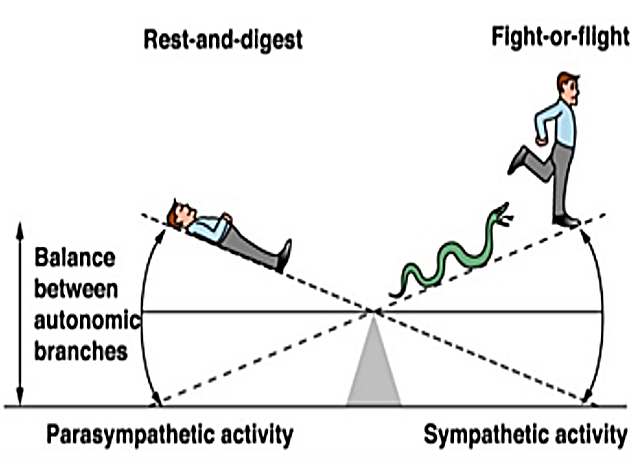Down Regulation
The autonomic nervous system consists of two opposing parts that can be divided into the following:
The Sympathetic or “fight or flight” / The Parasympathetic or “rest and digest”
There is a healthy balance between these two autonomic branches.
Activation of the sympathetic nervous system causes a release of the “fight or flight” hormones. Adrenaline and cortisol are the most important hormones released by the adrenal gland and their purpose is to give instant help to the skeletal muscles and brain to move and react to any real threat. This is supposed to be a short term event to get us out of danger. When the sympathetic nervous system is chronically activated these hormones cause inflammation and can raise the insulin level and increase the risk of diabetes, heart disease and cancer. Activation of the parasympathetic nervous system lowers the stress hormones and raises the "rest and digest" hormones which decrease inflammation and move the the body towards homeostasis.
Modern life has our sympathetic nervous system out of balance due to many factors:
Night light exposure
24/7 access to electronics
Circadian rhythm disruption
Chronic stress from financial, health, job and relationship worries
Constant exposure to negative news and violence
Lack of down time to play and exercise
Lack of time in nature
Social isolation
There are many methods to help with stress reduction. Clinical trials have demonstrated lowered stress and enhanced wellbeing with the following techniques:
Exercise
Meditation
Acupuncture
Prayer
Community or connection to others
These methods down regulate the sympathetic nervous system and up regulate the parasympathetic nervous system to lower adrenaline, cortisol and insulin in the body.
Glossary of Terms
Homeostasis - The state of steady internal physical and chemical conditions maintained by living systems. The body moving towards balance. This dynamic state of equilibrium is the condition of optimal functioning for the organism and includes many variables such as body temperature, fluid balance, pH, blood sugar level, electrolytes, immune and inflammatory responses.
Shinrin-Yoko or Forest Bathing - traditional Japanese practice of walking and spending time in the forest. It has been shown to lower stress, increase immune function, decrease depression, decrease blood pressure, decrease cortisol levels and increase activation of the parasympathetic nervous system while at the same time decreasing the activation of the sympathetic nervous system.
- Int J Environ Res Public Health. 2017 Aug;14(8):851.
Guided Imagery is a learned meditation technique that teaches people to guide their minds to a more relaxed and focused state. A therapist can direct the patient in guided imagery or a person can learn to guide the self with training.
Circadian rhythm - physical mental and behavioral changes that follow a daily cycle. The circadian rhythm responds primarily to light and darkness. An example is being awake in the day and asleep at night. Circadian rhythms can influence sleep- wake cycles, hormone release, eating habits and digestion, body temperature and other body functions.

